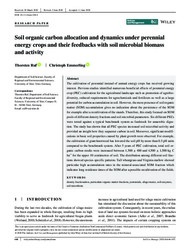Soil organic carbon allocation and dynamics under perennial energy crops and their feedbacks with soil microbial biomass and activity
DOI: https://doi.org/10.1111/sum.12614
Persistent URL: http://resolver.sub.uni-goettingen.de/purl?gldocs-11858/9132
Persistent URL: http://resolver.sub.uni-goettingen.de/purl?gldocs-11858/9132
Ruf, Thorsten; Emmerling, Christoph, 2020: Soil organic carbon allocation and dynamics under perennial energy crops and their feedbacks with soil microbial biomass and activity. In: Soil Use and Management, Band 36, 4: 646 - 657, DOI: 10.1111/sum.12614.
 |
Dokument öffnen: |
The cultivation of perennial instead of annual energy crops has received growing interest. Previous studies identified numerous beneficial effects of perennial energy crop (PEC) cultivation for the agricultural landscape such as promotion of agrobiodiversity, reduced requirements for agrochemicals and fertilizers as well as a large potential for carbon accumulation in soil. However, the mere presence of soil organic matter (SOM) accumulation gives no indication about the persistence of the SOM for example after a recultivation of the stands. Therefore, this study focused on SOM pools of different density fractions and soil microbial parameters. Six different PECs were tested against a typical benchmark system as feedstock for anaerobic digestion. The study has shown that all PEC species increased soil microbial activity and provided an insight how they sequester carbon in soil. Moreover, significant modifications in basic soil properties caused by plant growth were observed. For example, the cultivation of giant knotweed has lowered the soil pH by more than 0.5 pH units compared to the benchmark system. After 5 years of PEC cultivation, total soil organic carbon stocks were increased between 1,500 ± 400 and 4,500 ± 1,500 kg C ha-1 for the upper 10 centimetres of soil. The distribution among different soil fractions showed species-specific patterns. Tall wheatgrass and Virginia mallow showed particular high accumulation rates in the mineral-associated SOM fraction which indicates long residence times of the SOM after a possible recultivation of the fields.
Statistik:
ZugriffsstatistikSammlung:
This is an open access article under the terms of the Creative Commons Attribution-NonCommercial-NoDerivs License, which permits use and distribution in any medium, provided the original work is properly cited, the use is non-commercial and no modifications or adaptations are made.

